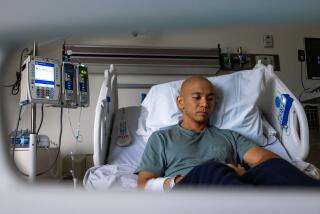Search Provides Hope for Leukemia Victim : Bone Marrow Donor Is Found for Leucadia Boy, 13
- Share via
Joshua Kaplan, the 13-year-old Leucadia boy whose fight with leukemia sparked a nationwide search for life-saving bone marrow, has found a donor who may save his life.
A qualified bone marrow donor was identified last month after a series of tests, and a marrow transplant that doctors believe will lead to the production of new, healthy blood for the youngster is scheduled for Sept. 28 in Seattle, officials said Tuesday.
The boy’s family is “very relieved, very hopeful, but we’re all still holding our breath,” said Leah Cole, a family friend and director of Diegueno Country School in Rancho Santa Fe, where the boy’s mother, Sherri, is a teacher.
Joshua’s leukemia had been in remission for nearly four years through cancer-fighting treatment, but it resurfaced last April and doctors said his best hope for survival would be a successful bone marrow transplant.
Computer Search for a Donor
But chances of finding the right donor were slim--1 in 15,000, given the exact matches of blood antigens necessary. A computer search was conducted of the 34,000 persons registered with the National Bone Marrow Donor Registry, and no one matched. In San Diego County, more than 5,000 persons had their own blood tested in response to a countywide plea for donors, according to the San Diego Blood Bank.
Finally, last month, a qualified donor was found. Officials will not disclose any information about the person, but Cole said she understood from the family that the donor is in his 20s, lives on the West Coast and has postponed an overseas vacation so that he can help Joshua.
With that news, Joshua--accompanied by his parents, Dr. Roy Kaplan and his wife, Sherri, and his younger sister, Jenny--flew recently to Seattle’s Fred Hutchinson Cancer Research Center, which with 60 beds is the largest bone marrow transplant unit in the world.
Joshua’s parents have declined comment, but said in a prepared statement at the cancer center, “The family appreciates the efforts and support of . . . the community. We know we wouldn’t be here without that, and its help in finding a donor for Josh.”
Threat of Infection, Bleeding
Susan Edmonds, a spokesman for the cancer research center, said the marrow transplant itself is a simple procedure, but that patients face a critical period afterward, when they are especially susceptible to uncontrollable bleeding because of the temporary loss of platelets and to life-threatening infection because the body’s immune system is virtually depleted.
Patients typically arrive at the center two to three weeks before a transplant for extensive medical examinations, she said. A week before the transplant, the patient is admitted and undergoes an intensive regimen of high-dose chemotherapy and/or radiation therapy, aimed at destroying the cancer in the marrow--the thick, almost granular substance within the bone structure that manufactures the blood’s red and white cells and the platelets that give the blood its clotting capability to prevent bleeding.
The same process that rids the cancer, however, also destroys the blood platelets and the patient’s immunity to infection.
The marrow will be withdrawn from the donor’s hip and flown to Seattle, where it will be transplanted that same day in a process that could last up to 10 hours. The marrow will be introduced through a catheter that leads directly to the heart’s atrium, from where it is carried into the bones and settles.
Afterward, the patient is placed in a sterile environment for up to 40 days to protect him from infection that would otherwise be ripe to occur before new, healthy blood is produced to establish a renewed immune system.
The patient usually is discharged from the hospital 40 days after the procedure, but then remains in a nearby apartment for another two months for out-patient observation.
The Only Alternative
Despite the risks, Edmonds said, patients usually have no alternative.
“This is their last chance for long-term survival,” she said of leukemia patients receiving bone marrow transplants. “If they don’t go through with it, they face almost certain death.”
More to Read
Sign up for Essential California
The most important California stories and recommendations in your inbox every morning.
You may occasionally receive promotional content from the Los Angeles Times.










